Cosmic Encounter - Visual Accessibility Analysis
If you’ve ever wondered what life from other worlds might be like, then look no further than Cosmic Encounter. There are 50 different aliens in the base game alone – and all are taking to the stars to reign supreme.
Introduction
Cosmic Encounter is, in my opinion, a must have space themed game. Easy to teach and quick to play, it’s a great mid-range sort of game. With a variable player count and a number of variant or optional rules, it’s also a very flexible game. But is it an accessible game for people who are blind and vision impaired?
There are a number of different components to Cosmic Encounter that are challenging for the blind or vision impaired player, particularly hidden information. But there is also a lot of public information, and a substantial part of the game involves dialogue. So from the outset, the answer isn’t straightforward, and a far more interesting accessibility case study because of it.
Before getting started with the game overview, I’d like to be clear that I’ll be discussion the Fantasy Flight Games version of Cosmic Encounter. There are also a lot of expansions for this version. I own three of them, Cosmic Incursion, Cosmic Conflict, and Cosmic Alliance, each of which adds an extra player colour and additional, but optional, rules. In this discussion I’m going to contain myself to the core mechanics of the game. I won’t touch on incursions, rifts, the reward deck, or even technology deck – none of which my friends and I typically use when playing the game.
So with that clear, let’s get started.
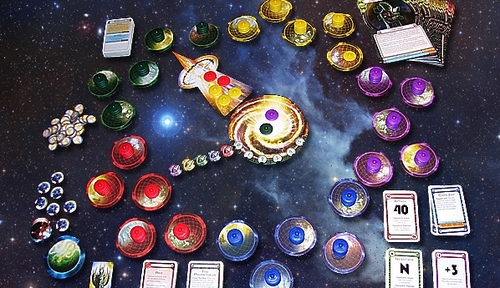
Image showing the game components of Cosmic Encounter
Game Overview
-
Game name: Cosmic Encounter
-
Publisher: Fantasy Flight Games
-
Player count: 3-5 (up to 8 with expansions)
-
Playing time: 60-120 minutes
In Cosmic Encounter, players take control of an alien race vying to establish itself amongst the stars. On their turn, a player will have an encounter with another player. During this encounter both players may call for allies before playing cards to resolve the conflict, either choosing to attack or negotiate. If the attacking player wins, or conducts successful negotiations, they may have a second encounter. Otherwise, it is the next player’s turn. Through encounters players will gain colonies. The first to five colonies wins the game – though it is possible and likely that multiple players will win the game.
At the start of the game every player will receive five planets and 20 ships in their colour. They can place a maximum of four ships in a stack, then position these stacks on their planets. Next, the flare cards will be shuffled and each player will be dealt two. Flares are alien powers that will make their way into players’ hands during the game. For now however they’re used to pick a race.
Players review the alien cards that correspond to their flare, then decide which of the two they want to play. Once decided, the alien of their choice is put in front them, the other is returned to the box, and the flares are shuffled into the main deck.
Once everyone has selected their race and all flares are shuffled in, each player is dealt eight cards from the main deck. In addition, the destiny deck is shuffled. Finally, the warp, doubling as the score tracker, is placed in the centre of the table with each player’s colony tracker, and the hyperspace gate is placed somewhere in reach.
On a player’s turn they will have one, or possibly two, encounters. At the start of an encounter, the player will recover one ship from the warp, and then draw the top card of the destiny deck. This card will indicate the player with which they will have an encounter. For example, if you drew a card that said “Red” you would have an encounter with red in his or her home system. There are also special and wild cards that might see you having encountering the player with the most colonies, or a player of your choice.
The player then takes the hyperspace gate, aims it at one of the planets in the system of the named colour, and assigns a minimum of one and a maximum of four ships to the gate. The player, as the attacker, then invites players of their choice to be allies in the attack. The defence then follow by the defending player who makes similar invitations. Invited allies then respond, providing one to four ships to which ever side they choose to support, if any.
The attacker and defender then choose an encounter card from their hand and place it face down in front of them. Encounter cards can be attack cards, which have a numerical value, negotiate cards, which have an N, or morph cards, which have an M and are a copy of whatever the other player plays. When ready, both players reveal their card.
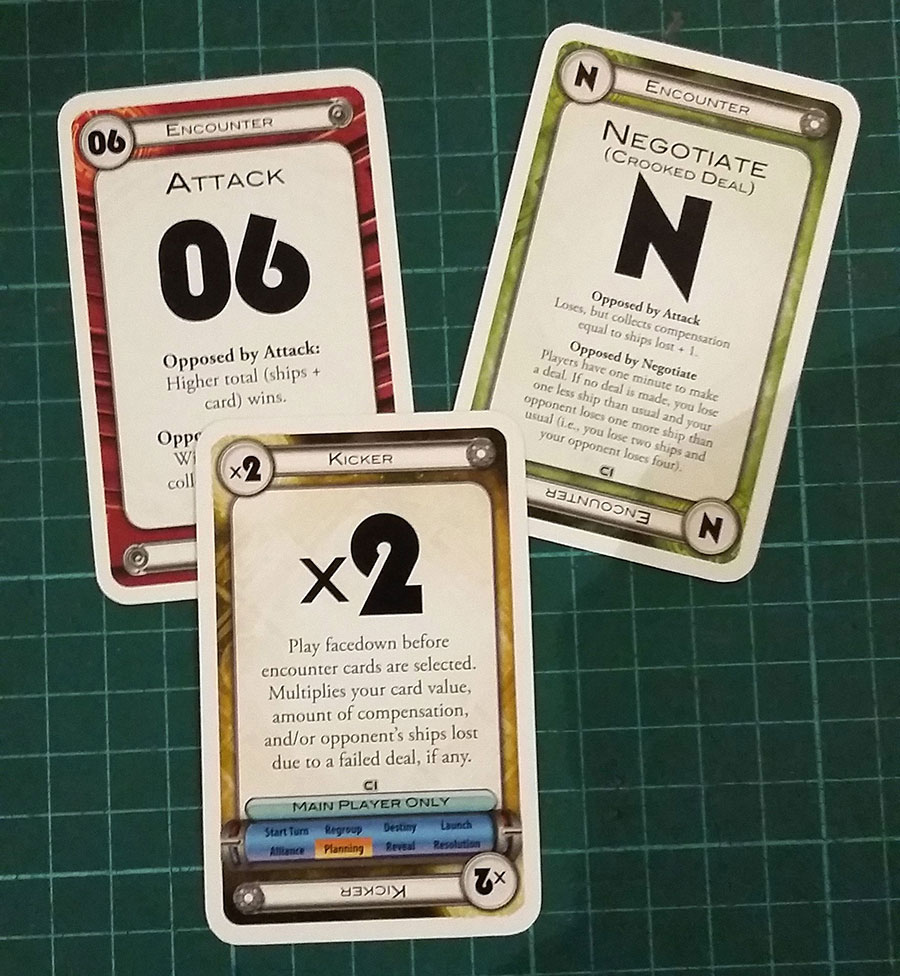 Image showing encounter cards
Image showing encounter cards
Attack cards automatically beat Negotiate cards. If both players played attack cards, each player adds the number on their card to the number of ships on their side in the encounter. The highest score wins, with ties going to the defender. Whichever side loses, sends all their ships to the warp – they are destroyed for now. If the attacker wins, they and any allies they had may establish a colony on the defender’s planet. If the defence wins, the defender receives no reward, but all allies receive one card from the main deck, or one ship back from the warp, or a combination of the two, for each ship they had involved in the encounter. Finally, if the loser played a negotiate card, they take a card at random from the winner’s hand for each ship they lost as compensation.
If both players played Negotiate cards, all allied ships are returned, all allies receive their ships back, and the attacker and defender have two minutes to broker a deal. If they fail to broker a deal, all ships they had in the encounter are sent to the warp as punishment for their poor diplomacy skills. Deals can involve anything, but players can only gain one colony at most from a deal – for example, a classic deal is “I’ll let you establish a colony on one of my planets if you let me establish a colony on one of yours”. Other things can include exchanging cards or promises – which might involve a level of deception and later promise breaking.
Once the encounter is resolved, if the attacker was the victor or brokered a successful deal, they may have an optional second encounter. If they did not win, or that was their second encounter, their turn ends. The first player to reach five colonies outside their home system wins.
In addition to the encounter cards mentioned already, there are a few other card types you will come across playing the game.
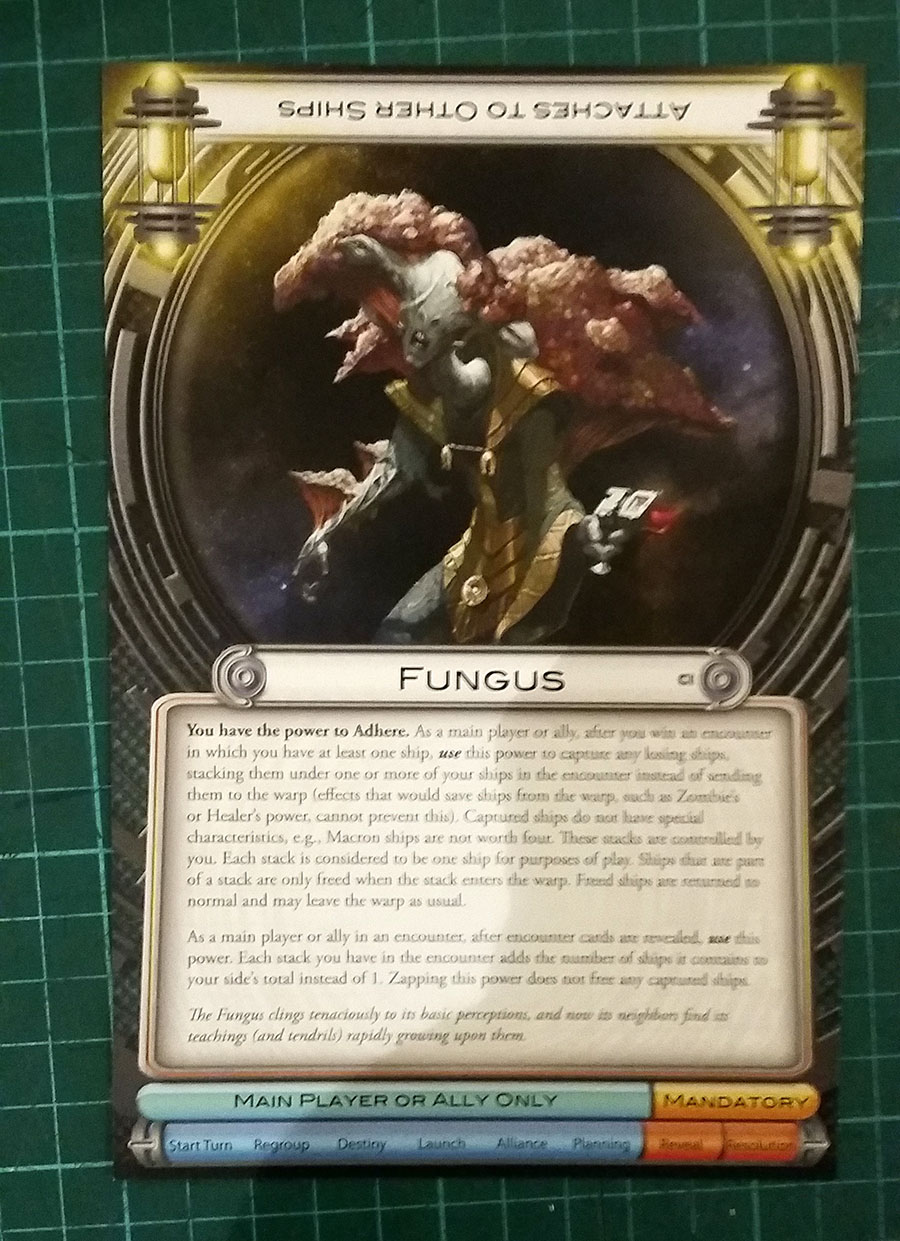 Image showing an alien race card
Image showing an alien race card
Alien race cards
Every player will have an alien race and all alien races have a unique power. The alien power cards indicate what phase an alien power is used in, whether it is optional or mandatory, and what the power actually does. All powers break or add to the game rules in some way, and some are greater than others. If a player loses three of their five home colonies, they may not use their alien power until they establish a colony in their home sector.
Flare cards
The flares are used during race selection, but then are shuffled into the main deck and may find their way into a player’s hand. Flares are like one use alien powers. They have two different effects. The wild effect occurs if you play the card and you are not the named race, while the super effect occurs if you play the flare and you are the named race. All flares indicate when they can be played and what they do. Note that super effects aren’t necessarily improved wild effects. They tend to be totally different.
Artefact cards
These are bonus cards that can be played by any player during the indicated phase. They have various effects which are outlined on the card.
Reinforcement and Kicker cards
These are cards that modify encounter cards. Kickers are placed facedown before encounter cards are chosen and multiply attack cards that the player plays. Reinforcements can be played by any player involved in the encounter to boost their side’s combat total.
Visual Accessibility
At first glance it can seem like Cosmic Encounter has a lot of complicated parts. On closer examination however you’ll soon find that the concepts are very straightforward, with most things being self explanatory. There are a number of components that will be challenging for blind and vision impaired players, but I do not think these challenges are insurmountable.
Vision Impaired
For a vision impaired player, the easiest thing to start with is the colour palette. Cosmic Encounter has all the usual colour challenges: blue, green, black; red, orange; white, yellow. All this information is, however, public. It’s a simple task to have sighted players identify how many of whose ships are where.
 Image showing planets and ships
Image showing planets and ships
And on that note, there aren’t many places ships can be. You’ll only be focusing on a single element at a time – the warp, destiny deck turn over planet involved in the encounter, and hyperspace gate – so there’s only a small amount of information to ask for. Once an encounter is resolved, it’s not that important to know how many ships are where, just how many colonies players are on. Again, there is a tracker whose information a sighted player can easily relay.
Update: One of our readers noted that the latest _Fantasy Flight Games version of the game has translucent ships. This may be aesthetically pleasing, but makes the ships harder to tell apart, even for fully sighted people._
Much of the game is player through discussion too. Inviting allies and brokering deals in particular. But even when cards are revealed and combat scores are calculated – it’s all public knowledge and can be done out loud.
The big challenge however comes from the cards, and Cosmic Encounter has a lot of them. I’m going to group them into two categories: the more accessible cards; and the less accessible cards.
The more accessible cards are encounter cards, reinforcements, and kickers. While these cards do have some small text, the main information – the value of the attack, reinforcement, or kicker, or the letters N or M – are printed in nice, clear, big, bold font. Font is black on white, but it is nice and big. Even someone with moderate vision impairment will likely be able to read this information.
Flares, artefacts, and alien powers are not so accessible. Artefacts are mediocre. They have larger than normal text, but it is thin, and the detail text on what the card does is normal size. All text is dark on light. You’ll likely want magnification and a desk light.
Flare cards have very small text, and sometimes quite a lot of it too. There’s also the information about when the flare card can be played. This is indicated by a red/orange highlighted space on a continuum of the game’s phases. All of this information is hard to read, even with magnification, and the flares are by far the worst in this regard.
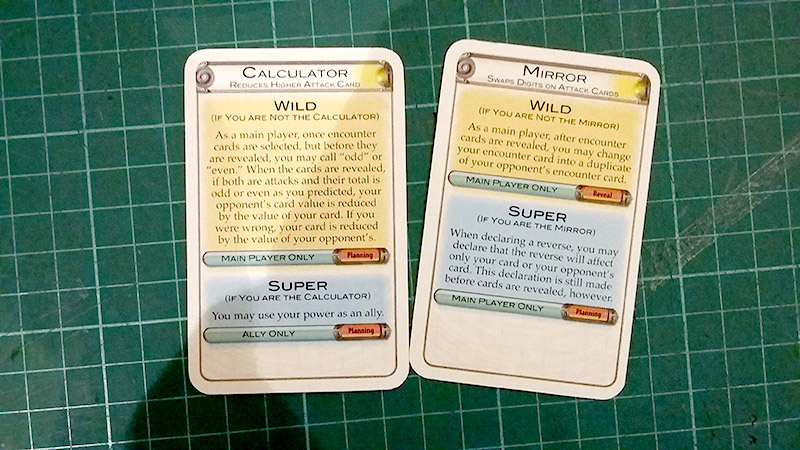 Image showing flare cards. Flares in particular will be tough for the vision impaired player to read even with magnification
Image showing flare cards. Flares in particular will be tough for the vision impaired player to read even with magnification
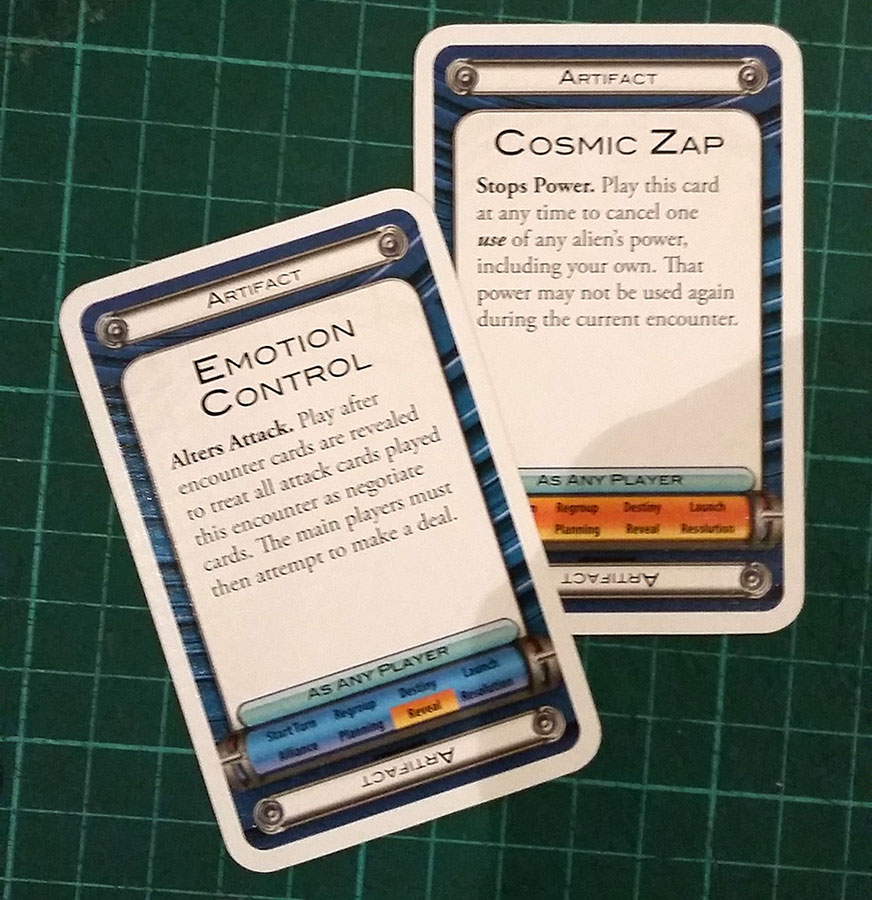 Image showing Artefact cards
Image showing Artefact cards
Finally, alien powers are a bit of a mix. Alien power cards are A5, so they’re quite large. They have an indicator as to the complexity of the race: green for low; orange moderate; red for high. I have a hard time finding this element, much less deciphering it. Alien power text can get very wordy and is, at best, normal size print. Accordingly, you’ll need varying amounts of magnification and reading light always. They also have a game phase continuum like flare cards, but it is larger and thus easier to decipher. The final elements on the card are a race picture and flavour text. These don’t really add anything for the vision impaired player, but do constitute half the card. Importantly though, alien powers are open information - bar two exceptions below – so sighted players can always read this information out to you.
Regarding the exceptions to alien powers being open information, the first is when selecting a race. The rules say that players should choose between their two flares and subsequent race in secret, revealing only when all have chosen. Bar one game, I’ve always ignored this rule. Because of the number of races and the propensity for them to get muddled up, it’s just easier to have multiple people searching multiple piles for the races everyone asks for.
The second exception is the variant “hidden race” rule. With this rule you keep your race secret until you use its power for the first time. I’ve played with it once and it is kind of neat, but it’s also not quite as cool as declaring your race and the game breaking power you have to the sounds of anguish from the other players.
Blind
As I have already discussed, public information in Cosmic Encounter is easily made accessible by sighted assistance. What is left is overcoming the challenge of Cosmic Encounter’s hidden information.
Marking cards in a basic way is not a viable solution given the variety of cards and the complex information. This means that labelling cards with braille would be necessary. Even then, a the blind player would still need the support of a reference guide. Encounter, reinforcement, and kicker cards can easily be brailled in full. Artefacts could be brailled in full, or the card name only supported by a reference guide. Flares will need their associated alien race name brailled with the flare’s effects covered by a reference guide.
As for alien powers, as mentioned they are open information, but because of the big empty space created by the race art, I think brailling the entire card may be possible, though it’d be easier to either braille the race name only and use a reference guide, or just use sighted assistance.
I cannot understate however what a mammoth undertaking compiling a reference guide to every flare and alien power in the game would be. Even with arguably better alternative marking methods such as HFC tags and QR codes. Many hands make light work though, and I see no reason why it would not result in a thoroughly enjoyable and accessible game at the end.
Another solution might be use of apps that photograph, OCR, and read back text. But use of such technology would likely be clunky as you try manipulate your hand in one hand and your phone in the other.
Conclusion
Cosmic Encounter is a bit of a mixed bag. Beyond the barrier of identifying the cards in your hand and what they do, Cosmic Encounter is a very accessible game with sighted assistance. The blind or vision impaired player loses nothing for being unable to see the board state themselves, either in difficulty or aesthetics.
But the barrier of hidden information is not insubstantial. Even vision impaired players will likely struggle with all cards bar encounter, reinforcement, and kickers. So they may find aid in braille labels just like a blind player – but an accessible card reference guide will still need to be on hand. Braille names to cards and assembling that reference guide will be a mammoth task.
But, in my opinion, if you were going to spend the time to make one game accessible, this is it. A good part, perhaps the majority, of the game is already easily accessible with sighted assistance and, most importantly, it’s fun. Oh boy is it fun.
I really can’t understate how much I enjoy playing this game. Every game I’ve played has had climactic endings, usually with multiple winners. And with the number of races involved, there’ll be something new every game.
If you and your friends have already produced a reference document for Cosmic Encounter, please share in the comments below, because it’d be great to share it.
Leave a comment